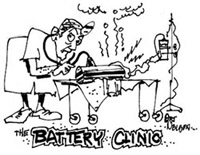"How should I store my batteries at the end of the season? What should I do to them when I
put them back in operation?"
The batteries should be removed from the transmitter and plane for longer term storage.
Here in the south where a lot of us work out of our garage work shops I recommend putting them in the refrigerator (not the
freezer) during the off season. While not so important where your workshop rarely gets above 23 degrees C (74 F) the refrigerator
is still a good bet. Why? The failure mode of Ni-Cds is separator failure; this is the material that keeps the plates from
touching each other. When it fails, the cell shorts. At higher temperatures it oxidizes faster. In fact, the rate doubles
for every 10 degrees C increase.
"Should I store my batteries charged or discharged?" It doesn't really
matter, they will self discharge in a few months stored at room temperature. If you are going to store them in the refrigerator
the charge will remain for a lot longer so I would discharge them first to 1.1 volts/cell and them put them away. Good cells
will just set there in the discharged condition (the voltage can vary considerably but is usually above 1 volt). In a battery
with damaged "worn out" separator in the cells, the cells are apt to short if left in a discharged condition. This
is actually good since it is the first indication of a cell that's going bad and it is best to replace the pack. A battery
left on trickle charge will seldom short out since it is in the charged condition and any short that tries to develop will
be zapped by the charge in the cell. Partial shorts (those having fairly high resistance) can be developing that can cause
the cells to self discharge at a higher rate than normal and possibly leave you short in the middle of a flight after you
just measured the cell when it came off charge with your ESV and everything looked OK.
The reason I recommend removing
the batteries from the transmitter and plane is to protect against "black wire" disease. Should a cell short while
in storage there is a high probability that there will be some leakage that can lead ultimately to the "black wire"
problem.
Now when your batteries are coming out of storage, before charging, check the voltage without a load on the
battery. It should read well over 1.0 volt/cell even if it has not been charged all winter. They should be essentially
fully discharged, flat as we say in the business. In this condition if the battery is going bad it will probably have shorted
and you will read zero volts on that cell. It may be a soft short, one that could be blown away merely by the simple action
of slow charging. Don't do it! It is just lying there waiting to bite you. Replace the pack. Cut out the "good"
cells if you want and use them in something less critical than your model. If you have access to a cycler running though a
couple of charge/discharge cycles is a good idea just to make sure you are getting the capacity you are suppose to. Anything
less than 80% of rated is suspect. Once at the field, pre-flight battery checks are in order, particularly at the beginning
of the season. Since those that religiously check their flight packs with an expanded scale volt meter seem to crash less
(due to battery failure) one must assume that the ritual is smiled upon by the R/C Gods.
cls 12/96 rev 1/07

